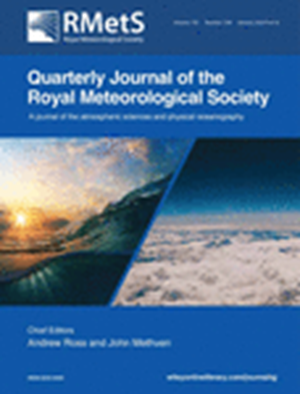通过应用于无缝概率预测的 R-vine copulas 生成合成降雨场
IF 2.9
3区 地球科学
Q2 METEOROLOGY & ATMOSPHERIC SCIENCES
引用次数: 0
摘要
许多后处理方法改进了单个地点的预报,但却消除了其相关结构。然而,这些信息对于预报更大范围的事件是必不可少的,例如河流流域等地区的降水总量,这与天气预警和洪水预报息息相关。我们提出了一种方法,利用拟合历史观测数据的 R-vine copula 将空间相关性重新引入后处理预报。该方法对各个地点的预测进行重新排列,并确保它们仍然表现出经过后处理的边际分布。它的工作原理与 "Schaake shuffle "和 "集合 copula 耦合 "等著名方法类似。不过,这些方法在空间相关性的来源上依赖于每个考虑地点的无并列排名,相比之下,copula 可以衡量给定排列与观察到的历史分布的比较程度。因此,后处理边际分布与空间相关性源之间无需紧密联系。这对后处理无缝预报有两方面的好处。首先,气象参数(如降水量)的分布原子为零,而无缝预报则可以对其进行排序。其次,无缝预报是其输入预报的优化组合,在比本文考虑的区域更大的尺度上可能与输入预报有空间偏移,从而导致众所周知的方法产生不合理的空间相关源。我们的研究结果表明,组合模型的校准效果会延续到拟议模型的输出中,也就是说,对区域预测的评估显示出与单个地点预测相似的预测质量改进。此外,我们还借助基于对象的指标对预测的空间相关性进行了评估,在这方面,与两种输入预测相比,建议的模型也有所改进。本文章由计算机程序翻译,如有差异,请以英文原文为准。
Generating synthetic rainfall fields by R‐vine copulas applied to seamless probabilistic predictions
Many post‐processing methods improve forecasts at individual locations but remove their correlation structure. However, this information is essential for forecasting larger‐scale events, such as the total precipitation amount over areas like river catchments, which are relevant for weather warnings and flood predictions. We propose a method to reintroduce spatial correlation into a post‐processed forecast using an R‐vine copula fitted to historical observations. The method rearranges predictions at individual locations and ensures that they still exhibit the post‐processed marginal distributions. It works similarly to well‐known approaches, like the “Schaake shuffle” and “ensemble copula coupling.” However, compared to these methods, which rely on a ranking with no ties at each considered location in their source for spatial correlation, the copula serves as a measure of how well a given arrangement compares with the observed historical distribution. Therefore, no close relationship is required between the post‐processed marginal distributions and the spatial correlation source. This is advantageous for post‐processed seamless forecasts in two ways. First, meteorological parameters such as the precipitation amount, whose distribution has an atom at zero, have rankings with ties. Second, seamless forecasts represent an optimal combination of their input forecasts and may spatially shifted from them at scales larger than the areas considered herein, leading to non‐reasonable spatial correlation sources for the well‐known methods. Our results indicate that the calibration of the combination model carries over to the output of the proposed model, that is, the evaluation of area predictions shows a similar improvement in forecast quality as the predictions for individual locations. Additionally, the spatial correlation of the forecast is evaluated with the help of object‐based metrics, for which the proposed model also shows an improvement compared to both input forecasts.
求助全文
通过发布文献求助,成功后即可免费获取论文全文。
去求助
来源期刊
CiteScore
16.80
自引率
4.50%
发文量
163
审稿时长
3-8 weeks
期刊介绍:
The Quarterly Journal of the Royal Meteorological Society is a journal published by the Royal Meteorological Society. It aims to communicate and document new research in the atmospheric sciences and related fields. The journal is considered one of the leading publications in meteorology worldwide. It accepts articles, comprehensive review articles, and comments on published papers. It is published eight times a year, with additional special issues.
The Quarterly Journal has a wide readership of scientists in the atmospheric and related fields. It is indexed and abstracted in various databases, including Advanced Polymers Abstracts, Agricultural Engineering Abstracts, CAB Abstracts, CABDirect, COMPENDEX, CSA Civil Engineering Abstracts, Earthquake Engineering Abstracts, Engineered Materials Abstracts, Science Citation Index, SCOPUS, Web of Science, and more.

 求助内容:
求助内容: 应助结果提醒方式:
应助结果提醒方式:


